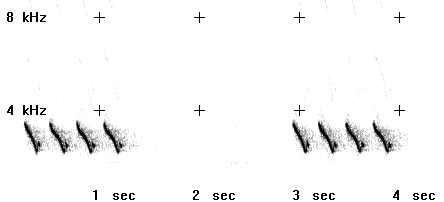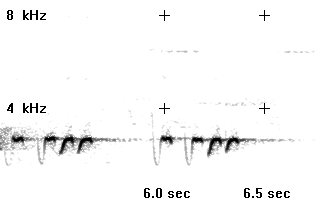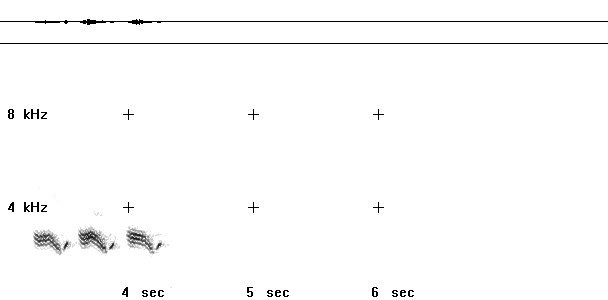Tufted Titmouse Sounds
Here are examples of sounds made by Tufted Titmice. Examples of commonly heard songs are presented here with references to the ways other people have described and recognized them. In addition, I've tried to make some sense of the vocalizations that are frequently lumped as "calls." At xeno-canto similar calls may be found and many contributors there have distinguished different kinds in their remarks on the recordings. But I don't know anyone who has done so systematically and comprehensively. I've divided calls based on primary frequency, similarity to Chickadee calls, and presumed use. After that, I've included examples of more complex sounds and sounds that occur in more complicated interactions between birds.
DDDI call the dominant elements here "D" notes by analogy with Carolina and Black-Capped Chickadee "ABCDD..." calls. While there are frequently introductory elements, and a fair bit of variety in them, these vocalizations all seem to end in a repetition of 3-4 or more notes give in the "lower, hoarser, harsh voice" that Nuttal mentions. Introductory elements, when present, are usually in the 8-11 kHz range and, at least in most of my recordings, are of the High tsk" sort. | |
[2005-md-01-11] is a call from Tanglewood. Many people describe this as an alarm call. See, for example, Mike Nelson, XC89187. |  |
[2009-03-15-08_26_42(tuti)] This appears to be an example of Nuttal's "called 'tshica dee-dee." It is easy to understand how people can confuse this with a Chickadee BCDD* call. | .jpg) <-you can drag this picture to scroll it-> |
| [2018-01-22-11_03_42] | .jpg) <-you can drag this picture to scroll it-> |
| 2018-01-26-10_19_36 |  |
High tskAnd Hi See. Similar to some CaCh vocalizations. Perhaps contact, warning calls. Some have suggested these are used when warning about a predator. Sometimes used as a first element in a vocalization ending in DDD. | |
| 2006-02-16_09_39 |  |
| 2015-03-30-10_08_58(mtairy-tuti-high) | .jpg) |
| [2017-02-19-09_40_46 (tanglewood-tuti)] | .jpg) |
[2003-02-06 (tanglewood-tuti)] This is a recording of several TuTi interacting near a bird feeder. These high notes are in the 9.5-11 hHz range. I have heard birds making these sounds during a wing flapping, head dipping display that I took to be courtship. Repeated high pitched notes of this sort, among Carolina Chickadees, are reported to be a signal that an avian predator is about. This might be the case with Titmice as well, but I have no evidence to spport the conclusion. | .jpg) |
SongsSongs are repetitions of a single element, usually a clear whistle in the 2-4kHz range. This element usually sounds 2-noted and so the song, with 3 repetitions of the element is often described as "peter-peter-peter". At a give locale, other elements (with 1, 3, or 4 notes) can be prevalent and these are usually shared by many individuals. Some songs consist of simple ascending or descending whistled notes. Others repeat more complex elements including a a usual 2-sloped (up-down) and 3-4 noted elements (wheep-did-er-ee). Only one type of element appears in each rendition; different elements are not combined in a single song. I don't know how many different element types individual birds use. | |
[2006-md-03-03] Tanglewood Lane. Martin St-Michel, XC390595 is a song based on a very similar element. |  |
| [004-2007-04-01 08_33_57(tanglewood-tuti)] | .jpg) <-you can drag this picture to scroll it-> |
[2005-md-01-23] A common song at Tanglewood 2005-2010. |  |
| < [2006-md-03-26(tuti)] | .jpg) |
| [2009-04-09-11_04_10(tuti)] | .jpg) |
| [2009-04-09-11_06_48(tuti)] | .jpg) |
| [001-2007-04-17 11_28_28(pater-tuti)] | .jpg) |
| [2017-03-25-10_15_28(mt-airy-arb-tuti)] | .jpg) |
| [2015-03-30-10_06_44(mtairy-tuti)] | .jpg) |
20 April 1999. 9:00 AM, Tanglewood. This, along with part b and part c are recordings of a collection of tuti singing in response to each other. Very likely the same bird appears in 'a' and 'c', although there were between 4 and 6 birds present so it impossible to be certain. At least 3 different songs were sung; once one bird started a new song, those answering it usually shifted to using that song as well. So this is evidence of "song matching" in titmice and (direct evidence and as a consequence of sharing) that one bird can sing several different songs. |  |
[2017-02-19-09_42_44(tanglewood-tuti)] Note that the sonogram shows a second bird making Hi See vocalizations in the background at 4,6,8.5 secs. | .jpg) |
| [2018-01-028-09_41_52(tanglewood-ms)] | .jpg) |
[ 2005-md-01-97] is a song from Tanglewood in 2005. Compare with Matt Brady, XC360933 is a song using a similar element. |  |
| [2015-04-01-09_56_52(richardson-tuti)] | .jpg) |
[tuti11c] Part c of a 1999 recording form Tanglewood. |  |
[2017-03-11-10_18_38(tanglewood-tuti)]Two birds are singing/calling in this recording. The more melodic one is a song based on a more complicated element, perhaps the sort Nuttal described as "whip-tom-killy-killy." The other bird is, I think, singing as well. While the harshness of the element making up the vocaliaztion is unusual, it is in the right frequency range, has the simple 1-2 noted form, and is given as frequently and as many times in a group as would be expected in a song. | .jpg) |
tuti11b Part b of a 1999 recording form Tanglewood. Another example of a song based on a 4-noted element. |  |
[tuti15.mp3] A song from Tanglewood Lane, 22 Feb 2004 based on and unusual element. . Accessible at Paul Driver, XC375653 is similar and described as a song. Daniel Lane, XC101646 is similar as well, but described as "unusual call". |  |
Other sounds
| |
| [2018-01-16-12_30_44] |  |
[2005-02-06-md-01-19_21] Here are 6 Titmice in some sort of chase or altercation and using many different kinds of calls and bits of song. |  <-you can drag this picture to scroll it-> |
A. C. Bent on Titmouse voice
Voice.--The notes of the tufted titmouse are many and varied, mostly loud and generally pleasing; it is a noisy bird. Aretas A. Saunders has sent me the following excellent notes on the subject: "The loud, whistled call of the tufted titmouse, commonly translated as peto, peto, is in about the same status as song as the phoebe whistle of the chickadee. That is, it is used by both sexes and, apparently, at almost any season of the year. Also, like the chickadee, the birds respond to an imitation and come to the imitator very readily.
"The song is loud, clear, and lower-pitched than the chickadee's phoebe. It is also quite variable; I have a number of records and no two of them are alike. The song consists of a two-note phrase, repeated over and over three to eleven times, according to my records. The two-note phrase is more frequently with the first note high and the second low. The interval between may be one, one and one-half, or two tones. The pitch of the notes varies in different songs, or different individuals, from A" to A"', that is, between the highest of two A's on the piano. The majority of songs in my records are between E"' and C"'. "Sometimes the two-note phrase sounds like peto, at other times like wheedle or taydle. When the pitch goes up, instead of down, the phrase is commonly written daytee; the same pitches and pitch intervals are common but it often sounds like toolee, and sometimes the first note is short, and it is like tleet or tlit. I have recorded all these variations in the field, writing down what each particular song sounded like to me at the time it was heard.
"An occasional phrase slurs down, like teeoh, and there are rarely phrases of three notes, such as wheedleoh, or of one note, whee, each repeated a number of times. Sometimes a song begins or ends with notes unlike the rest, as tidi, waytee, waytee, waytee, etc., or wheedle, wheedle, wheedle, whee, whee."
Dr. Dickey mentions a number of slightly different interpretations of some of the above notes, and adds some that are quite different, such as piper-tee, piper-tee, piper-tee; ah-peer, ah-peer; chee-chu, chee-chep; and wheep-did-er-ee, ending with purty-purty-purty.
Nuttall (1832) devotes considerable space to the voice of the tufted titmouse, and aptly remarks that "though his voice, on paper, may appear to present only a list of quaint articulations. . .yet the delicacy, energy, pathos, and variety of his simple song, like many other things in nature, are far beyond the feeble power of description." He mentions a very lively and agreeable call of 'whip-tom-killy-killy; and then, "in a lower, hoarser, harsh voice, and in a peevish tone, exactly like that of the Jay and the Chickadee, day-day-day-day, and day-day-day-day-dait; sometimes this loud note changed into one which became low and querulous. On some of these occasions he also called 'tshica dee-dee. The jarring call would then change occasionally into kai-tee-did did-dit-did."
Several other observers have noted the resemblance of some of these notes to the notes of the Carolina chickadee. The single whistled call sounds like the whistle of a man calling his dog. It can readily be seen from a study of the above interpretations how easy it is for a novice to confuse the voice of the titmouse with that of the Carolina wren, the chickadee, or even the cardinal. All observers agree that the titmouse is a loud and persistent singer for nearly all the year; it is a joy to hear it tuning up in January, when so many other birds are silent. The song increases in frequency and intensity when the nuptial season approaches in February; early in spring its oft-repeated peto note is given so constantly that it may become monotonous and even tiresome. No wonder that the bird is locally known as the "Peter bird."